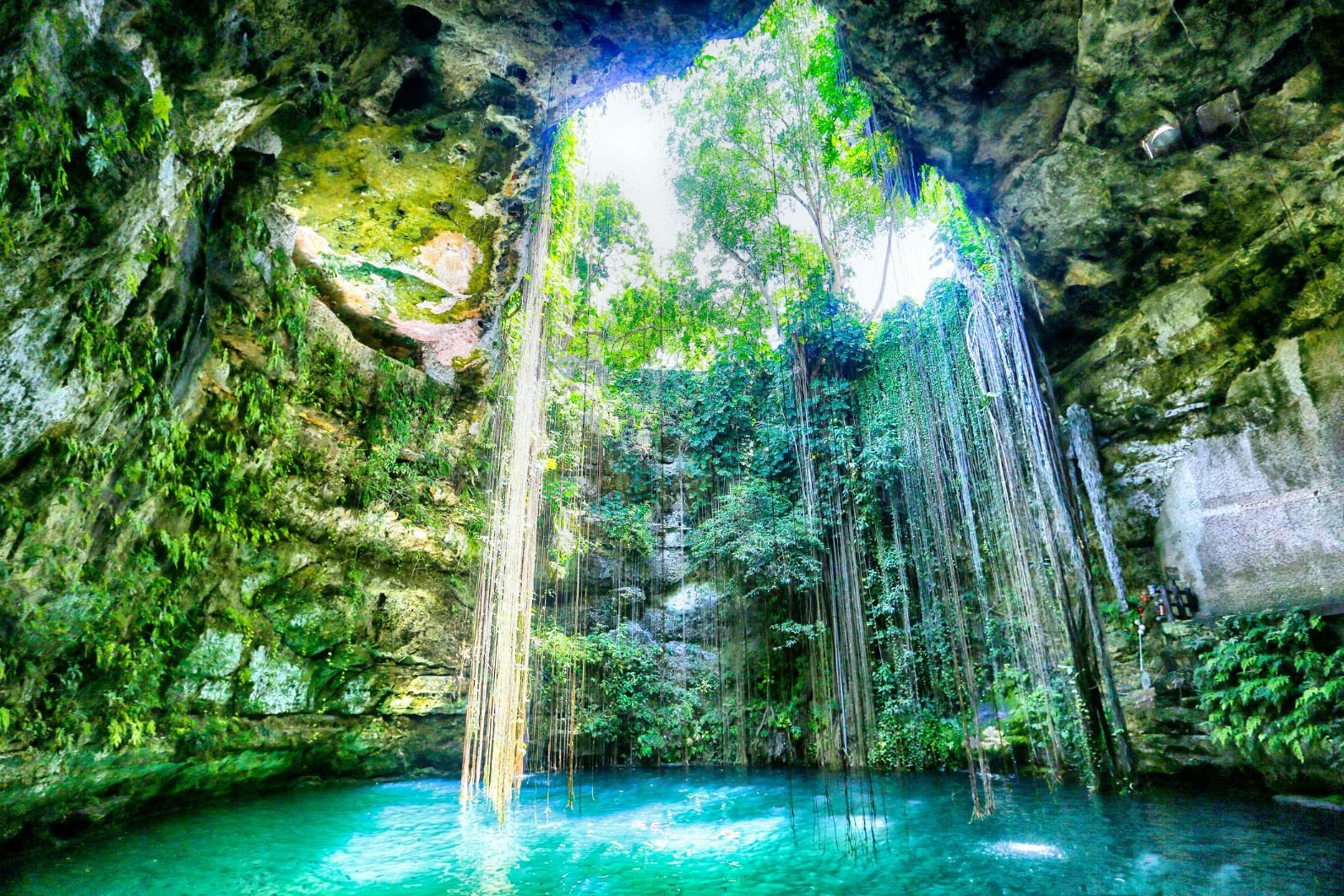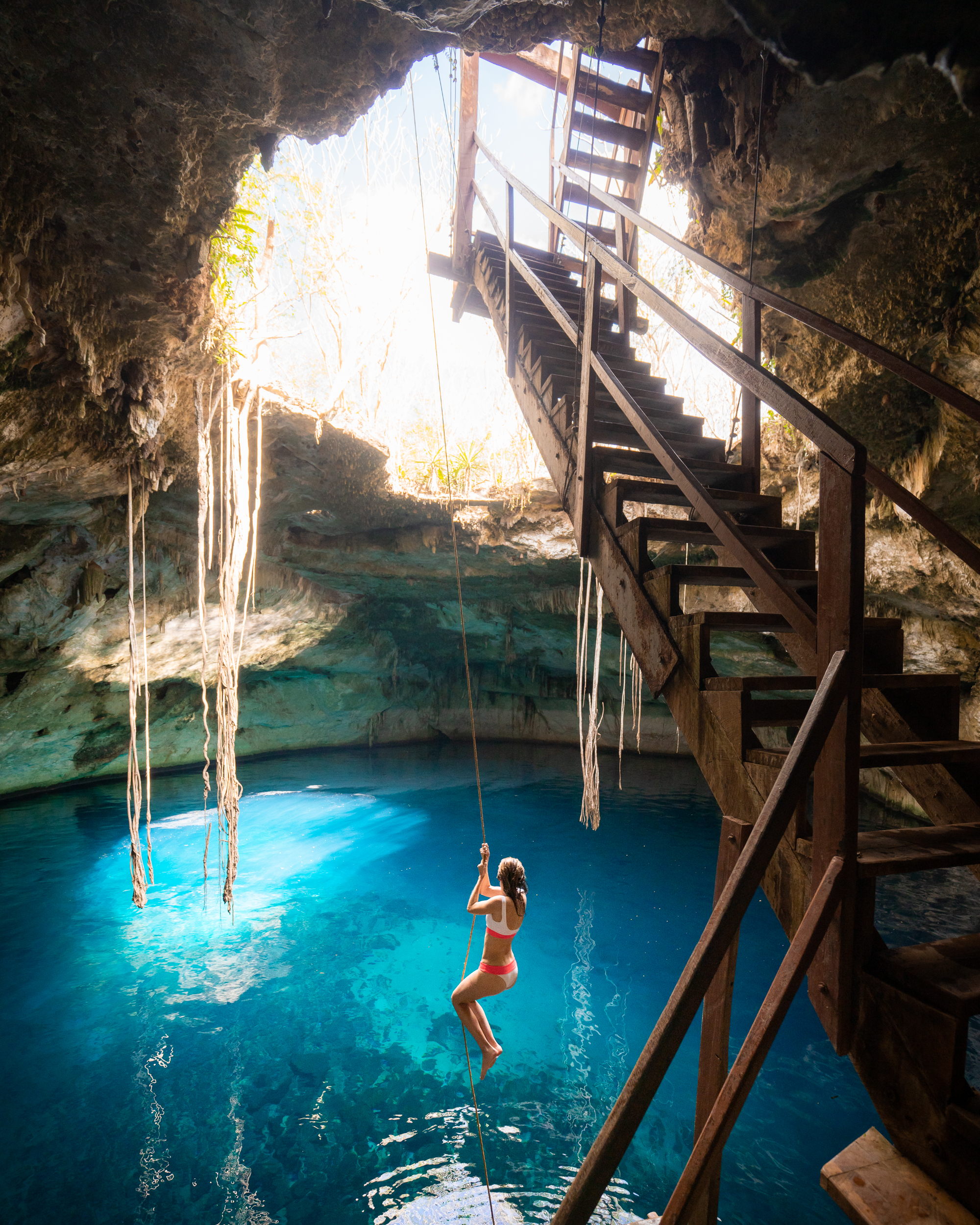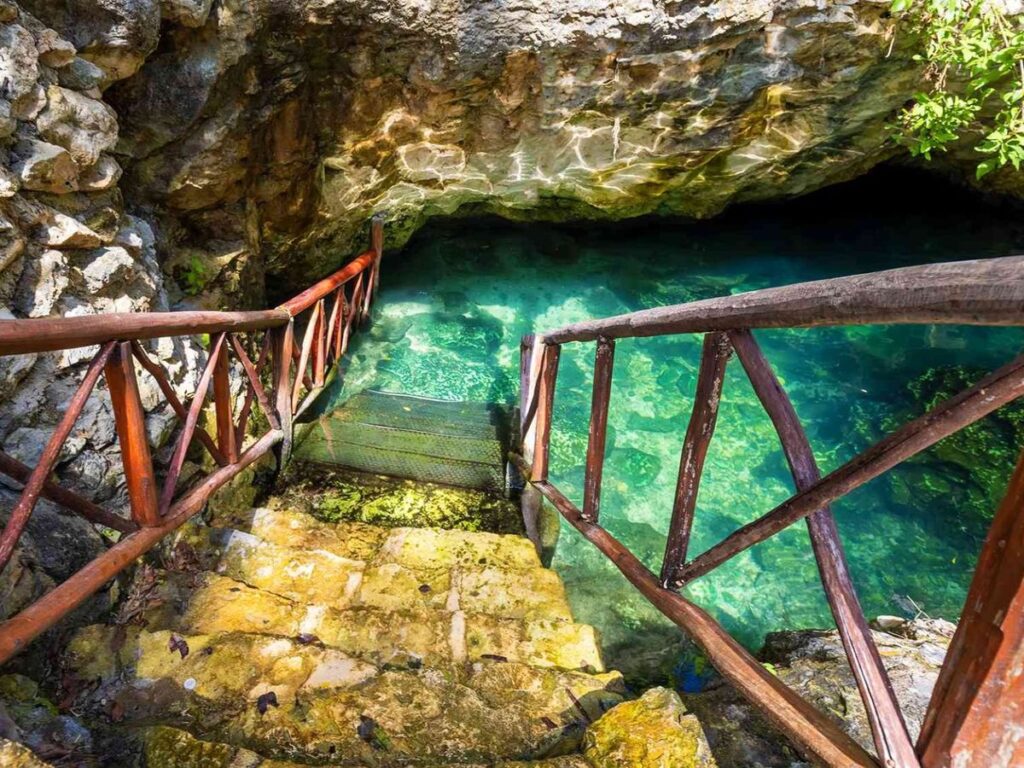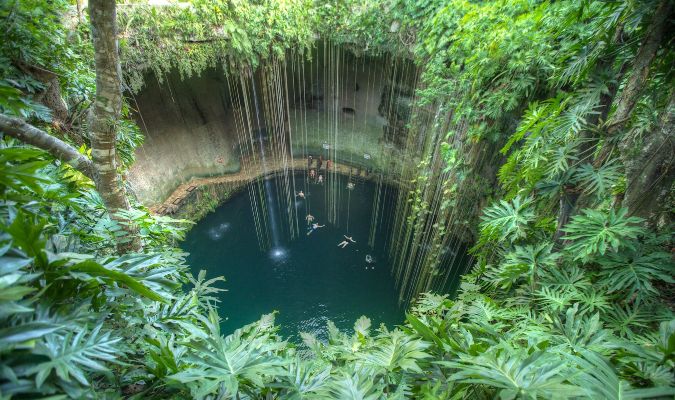Have you ever heard of Mexico’s cenotes? If not, you’re in for a treat! These stunning natural formations are sure to take your breath away and provide you with a unique and unforgettable experience. In this article, we’ll delve into the world of Mexico’s cenotes and explore their incredible natural beauty. So, get ready to discover a hidden gem in Mexico’s diverse landscape.
Mexico is known for its vibrant culture, delicious cuisine, and picturesque beaches, but it also boasts an impressive array of natural wonders. One of these wonders is the cenotes, which are natural sinkholes formed by the collapse of limestone. These cenotes are often filled with crystal-clear, turquoise water, creating a truly enchanting sight. They are found all over Mexico, but the Yucatan Peninsula is particularly famous for its numerous cenotes. From small and intimate cenotes hidden in the jungle to large, open-air cenotes with breathtaking views, there is a cenote for everyone to explore and enjoy. In our upcoming article, we’ll take a closer look at some of the most beautiful cenotes in Mexico and provide you with tips on how to make the most of your cenote adventure. So, get ready to dive into Mexico’s cenotes and discover nature’s hidden beauty.

The History of Cenotes
Mexico’s cenotes have a rich history that dates back thousands of years. These natural wonders have captivated both locals and tourists, offering a unique experience that connects people with the beauty of nature. In this article, we will explore the history and cultural significance of cenotes, the different types of cenotes, and the various activities one can enjoy while exploring these hidden gems.
The Formation of Cenotes
Cenotes are formed through a natural geological process that occurs over millions of years. These breathtaking sinkholes are the result of collapsed limestone bedrock, exposing the clear and pristine groundwater that lies beneath the surface. The Yucatan Peninsula in Mexico is known for its abundance of cenotes due to its unique geology.

Mayan Civilization and Cenotes
Cenotes hold immense cultural significance for the ancient Mayan civilization that once thrived in Mexico. These natural formations were considered sacred by the Mayans and were believed to be portals to the underworld. Mayans would often use cenotes for religious ceremonies, as a source of freshwater, and as navigational landmarks.
The Mayans considered cenotes to be a gateway to the gods and would perform rituals and sacrifices in these natural pools. Many cenotes have been discovered to contain artifacts and remains from these ancient rituals, providing valuable insights into Mayan culture and history.
Cultural significance of Cenotes
Today, cenotes continue to hold cultural importance for the local Mexican communities. They are seen as sacred sites and are still used for spiritual ceremonies and rituals. Visitors to cenotes are often encouraged to show respect and reverence to these natural wonders, understanding their cultural significance.

Types of Cenotes
There are three main types of cenotes: open-air cenotes, cave cenotes, and semi-open cenotes. Each type offers a unique experience and allows visitors to explore the diverse beauty of these natural formations.
Open-air Cenotes
Open-air cenotes, as the name suggests, are located in open areas and are characterized by their crystal-clear turquoise water. These are the most common type of cenotes, and their open nature allows for easy access and a refreshing swimming experience.
Cave Cenotes
Cave cenotes are hidden beneath the surface and offer a more adventurous and eerie experience. These cenotes are located in underground caves, and visitors can explore the dark passages and marvel at the stalagmites and stalactites that adorn the cave walls.
Semi-open Cenotes
Semi-open cenotes are a combination of open-air and cave cenotes. They feature a partially covered opening, creating a unique blend of light and shadow. These cenotes offer a mystical and tranquil setting, inviting visitors to relax and immerse themselves in the natural beauty.
Exploring Cenotes: A Unique Experience
Exploring cenotes is not just about admiring their beauty, but also about engaging in various activities that allow you to fully experience their magic. From swimming and snorkeling to ziplining, there’s something for everyone to enjoy.
Swimming in Cenotes
One of the most popular activities in cenotes is swimming in their crystal-clear waters. Whether it’s in an open-air cenote or a cave cenote, the experience of swimming surrounded by nature’s beauty is truly extraordinary. The cool and pure water of cenotes offers a refreshing escape from the heat of Mexico’s tropical climate.
Snorkeling and Diving in Cenotes
For those who want to explore the underwater world of cenotes, snorkeling and diving are incredible options. The cenote’s clear water provides excellent visibility, allowing snorkelers and divers to observe the diverse marine life and unique geological formations beneath the surface.
Ziplining over Cenotes
For the adrenaline seekers, ziplining over cenotes offers a thrilling and unforgettable experience. The exhilarating feeling of gliding through the air, while taking in the breathtaking views of the cenote below, is sure to get your heart racing. This activity allows you to appreciate the sheer size and beauty of these natural wonders from a completely different perspective.

The Biodiversity of Cenotes
Cenotes are not only visually stunning but also support a diverse ecosystem of flora and fauna. The unique combination of freshwater and sunlight creates a nurturing environment for a wide variety of plant and animal species.
Flora and Fauna in Cenotes
Cenotes are often surrounded by lush vegetation, including mangroves, ferns, and tropical flowers. These plants thrive in the cenote’s humid and semi-submerged environment, creating a picturesque backdrop for visitors.
Underwater, cenotes are home to a plethora of species, ranging from small fish and turtles to larger aquatic mammals such as manatees. The clear water allows for excellent visibility, offering a glimpse into the vibrant underwater world.
Endangered Species in Cenotes
Unfortunately, some species that inhabit cenotes are endangered or at risk due to factors such as pollution and habitat destruction. Conservation efforts are crucial to protect these delicate ecosystems and ensure the survival of these species. By practicing responsible tourism and supporting conservation organizations, visitors can contribute to the preservation of cenotes and their biodiversity.
Cultural and Historical Importance of Cenotes
Cenotes have played a significant role in the cultural and historical heritage of Mexico. They have been witness to centuries of human activity, including sacred rituals, ancient ceremonies, and important archaeological discoveries.
Sacred Rituals and Ceremonies in Cenotes
For the Mayans, cenotes were not only a source of freshwater but also a spiritual gateway. The Mayan civilization believed that cenotes were portals to the underworld, and they conducted various rituals and ceremonies within their depths. Today, local communities continue to carry out traditional ceremonies and rituals in cenotes, preserving their cultural significance.
Archaeological Discoveries in Cenotes
Over the years, numerous archaeological discoveries have been made in cenotes, offering valuable insights into the ancient history of Mexico. These discoveries include artifacts, sacrificial remains, and even complete skeletons of ancient Mayans. Archaeologists continue to explore cenotes, uncovering fragments of the past and shedding light on the rich history of the region.

Responsible Tourism and Cenotes
As visitors, it is essential to practice responsible tourism and contribute to the conservation and preservation of cenotes. By adopting sustainable practices, we can ensure that these natural wonders continue to thrive for future generations to enjoy.
Preservation of Cenotes
Preserving the natural beauty of cenotes involves minimizing our impact on their delicate ecosystems. It is important to follow guidelines set by local authorities and tour operators when visiting cenotes, such as avoiding the use of chemicals, not disturbing the flora and fauna, and disposing of waste responsibly.
Sustainable Practices in Cenotes
Many tour operators in Mexico have embraced sustainable practices to protect the environment and ensure the long-term sustainability of cenotes. These practices include using biodegradable sunscreen and shampoos, providing educational programs to visitors, and actively participating in conservation initiatives.
Popular Cenotes in Mexico
Mexico is home to numerous stunning cenotes, each possessing its own unique features and allure. Here are three popular cenotes that are definitely worth visiting:
Ik Kil Cenote
Located near the renowned archaeological site of Chichen Itza, Ik Kil Cenote is a true natural wonder. Its enormous circular opening and cascading vines create a lush and serene atmosphere. Visitors can swim in its turquoise waters and even enjoy the sight of daring cliff divers plunging into the cenote.
Gran Cenote
Situated near the town of Tulum, Gran Cenote enchants visitors with its clear waters and intricate cave structures. Snorkeling in Gran Cenote allows for an up-close and personal encounter with the diverse marine life that inhabits its underwater world.
Dos Ojos Cenote
Dos Ojos Cenote, located in the Riviera Maya, is a popular destination for cave divers. Its intricate underground cave systems offer a mesmerizing experience for those with an adventurous spirit. Diving through the labyrinthine passages and exploring the hidden chambers is an unforgettable journey into the heart of the cenote.
Adventure Activities in Cenotes
In addition to swimming, snorkeling, and diving, cenotes offer a range of thrilling adventure activities that cater to adrenaline junkies and those seeking unique experiences.
Cenote Cliff Jumping
For the thrill-seekers, cenote cliff jumping is a must-try activity. Many cenotes offer platforms at varying heights, allowing visitors to jump into the refreshing waters below. The rush of adrenaline combined with the awe-inspiring natural surroundings is an exhilarating experience like no other.
Cenote Cave Exploration
Exploring the depths of the cave cenotes is an adventure in itself. With the guidance of experienced cave divers or guides, visitors can venture into the darkened passages, discovering hidden chambers and marveling at the geological wonders that lie beneath the surface.
Cenote Kayaking
Kayaking in cenotes offers a tranquil and intimate way to explore these natural formations. With a kayak, you can paddle through the calm waters of open-air cenotes, immersing yourself in the serenity of nature while taking in the breathtaking surroundings.
Cenotes and Ecotourism
The beauty and significance of cenotes have made them an integral part of Mexico’s ecotourism efforts. Ecotourism aims to promote sustainable and responsible travel practices that benefit both the environment and the local communities.
Benefits of Ecotourism to Cenotes
Ecotourism provides the opportunity for visitors to appreciate and learn about the natural wonders of cenotes while contributing to their preservation. The revenue generated from ecotourism activities can be used to fund conservation initiatives, support local communities, and raise awareness about the importance of protecting these delicate ecosystems.
Cenote Conservation Organizations
Several organizations in Mexico are dedicated to protecting and conserving cenotes. These organizations work tirelessly to implement conservation strategies, conduct research, and educate the public about the significance of cenotes. By supporting these organizations through donations or volunteering, travelers can actively contribute to the preservation of cenotes.
Nearby Attractions and Excursions from Cenotes
Exploring cenotes provides the perfect opportunity to discover other nearby attractions and embark on exciting excursions. Mexico is not only home to stunning natural wonders but also ancient ruins and vibrant cultural sites.
Chichen Itza
The ancient city of Chichen Itza is a UNESCO World Heritage Site and one of Mexico’s most iconic archaeological sites. Located near Ik Kil Cenote, Chichen Itza offers visitors the chance to explore impressive Mayan ruins, including the famous El Castillo pyramid and the Temple of the Warriors.
Tulum Ruins
Situated on the stunning Caribbean coastline, the Tulum ruins offer a glimpse into the past of the Mayan civilization. Visitors can explore the well-preserved ruins, perched atop a cliff overlooking turquoise waters. Tulum also features beautiful beaches, making it a popular destination for sun-seekers.
Xcaret Park
Xcaret Park, located near Playa del Carmen, is a nature and cultural theme park that offers a blend of adventure, education, and entertainment. Visitors can swim in underground rivers, snorkel in the Caribbean Sea, and learn about Mexico’s rich cultural heritage through captivating performances and exhibits.
The Cultural Heritage of Cenotes
Cenotes are not only natural wonders but also an integral part of Mexico’s cultural heritage. They hold deep significance for traditional indigenous communities and are steeped in historical stories and legends.
Traditional Indigenous Communities and Cenotes
Cenotes continue to hold spiritual and cultural importance for traditional indigenous communities in Mexico. These communities often live in close proximity to cenotes and have a deep connection with these sacred sites. Visitors can learn about their traditions, folklore, and rituals, gaining a deeper understanding of the cultural significance of cenotes.
Historical Stories and Legends about Cenotes
Throughout history, cenotes have been the subject of many fascinating stories and legends. From tales of mythical creatures guarding the depths of the cenotes to stories of ancient treasures hidden within them, these narratives add an element of mysticism and intrigue to the already enchanting world of cenotes.
Experiencing Serenity and Tranquility in Cenotes
Cenotes provide the perfect setting for relaxation and reflection, away from the hustle and bustle of everyday life. The serene atmosphere, combined with the breathtaking natural beauty, makes cenotes an ideal location for activities that promote wellness and inner peace.
Yoga and Meditation in Cenotes
Cenotes offer a peaceful environment for practicing yoga and meditation. The tranquil surroundings, coupled with the soothing sound of water, create a harmonious atmosphere that allows for a deeper connection with nature and oneself. Many wellness retreats and yoga studios in Mexico offer classes and workshops held in cenotes, providing a truly rejuvenating experience.
Wellness Retreats in Cenotes
Wellness retreats in cenotes offer a holistic approach to health and well-being. These retreats combine yoga, meditation, healthy eating, and other wellness activities in the serene and healing environment of cenotes. Participants can immerse themselves in nature, rejuvenate their mind and body, and leave feeling refreshed and revitalized.
Cenotes: A Photographer’s Paradise
Cenotes provide a captivating backdrop for photographers, offering endless opportunities to capture the natural beauty and unique features of these breathtaking sinkholes.
Capturing the Beauty of Cenotes
Whether it’s the vibrant turquoise water, the lush greenery surrounding the cenote, or the stunning reflections on the surface, cenotes offer a plethora of photography subjects. The interplay between light and water creates captivating compositions that are sure to leave photographers inspired.
Tips for Photography in Cenotes
To capture the true essence of cenotes, there are a few tips that photographers should keep in mind. Firstly, it’s important to respect the environment and follow any guidelines set by the cenote authorities. Secondly, utilizing natural light and understanding the unique lighting conditions of cenotes can greatly enhance the quality of your photographs. Lastly, capturing the details and textures of the cenote, such as the rock formations and underwater life, can add depth and interest to your images.
Conclusion
Exploring Mexico’s cenotes is a journey into the awe-inspiring beauty of nature. These natural wonders offer not only breathtaking landscapes but also a deeper connection with the cultural heritage and history of Mexico. From swimming and snorkeling to cave exploration, cenotes provide a wide range of activities for all types of travelers.
While enjoying their beauty, it is vital to practice responsible tourism and support conservation efforts to ensure the preservation of these delicate ecosystems. By doing so, we can continue to appreciate and explore the beauty of Mexico’s cenotes for generations to come. So pack your swimsuit, grab your camera, and embark on a journey into the heart of nature’s beauty in Mexico’s cenotes.